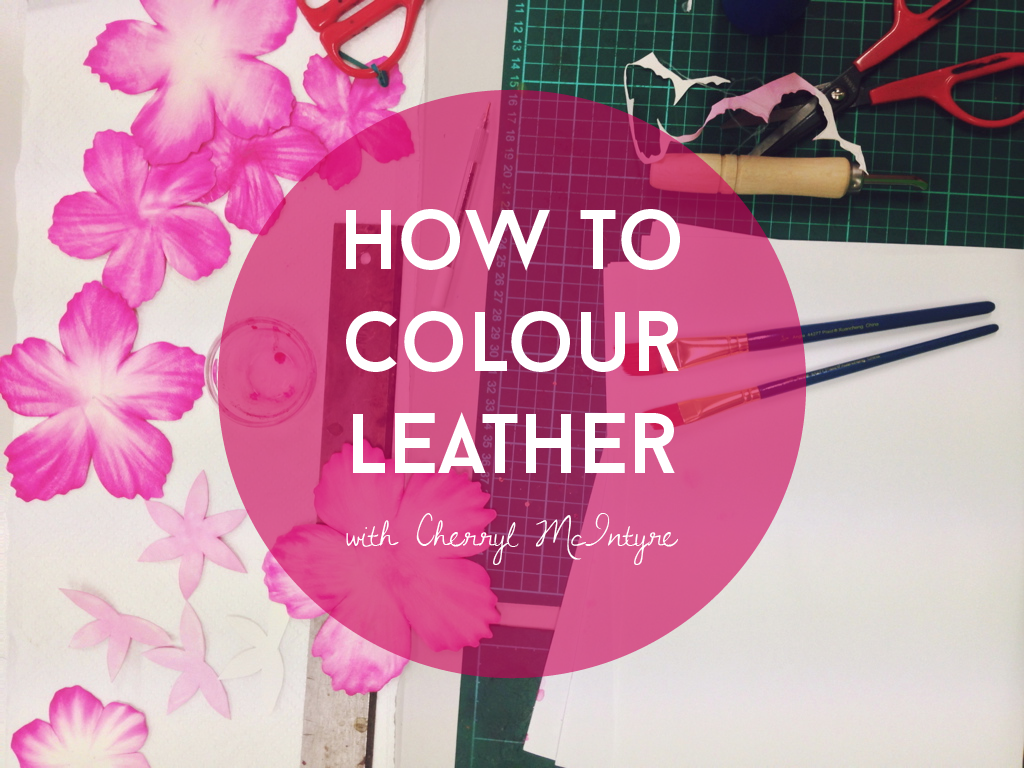Leather Craft Basics: How to Colour Leather Flowers February 26, 2016 15:03

If you've ever done one of my workshops, you'll know how much I love the way vegetable-tanned leather responds to leather dyes. The possibilities are endless! You can blend just two or three colourways together and get so many beautiful shades - as many different colours as in nature itself - to match any outfit and any creation.
But like anything, it takes a lot of practice, experimentation and skill to achieve exquisite results.
I go into a great amount of detail on how to create vibrant and life-like leather flowers using leather dyes in my online tutorials through Hat Academy, but here are some of the essentials I tell all my students.
Colouring Leather: The Basics
1. No two hides are created equal
I could talk for hours on the natural beauty and character of an individual piece of leather, but to keep things brief I'll just say this: Leather is a natural material and as such, scars, insect bites and natural markings are a given. Treat these markings as its built-in Certificate of Authenticity. The more you work with this beautiful medium, the more you will come to appreciate its unique characteristics.

Vegetable tanned leathers straight out of the tannery (left),
and my specially developed Flower Leather (right).
When it comes to dyeing leather, you want to be sure you're working with uncoated, natural vegetable-tanned leathers, not chrome (more on the difference between vegetable-tanned and chrome leather coming soon). This is your base and it is crucial to get this right - colour and thickness is key.
Different tanneries use different tannery solutions. The image above illustrates just how much the finished colour of standard vegetable-tanned leathers (the three on the left) can vary, depending on the tannery.
If you want to achieve really vibrant colours your standard vegetable tanned cowhide won't cut it. The leather I use has been specially developed for my Leather Flowers and provides the perfect base for superb colouring.
2. Dilute and build
You’ve heard of the bend-and-snap, let me introduce you to the dilute-and-build!
Always, always, always dilute your dye. You want to start with a light wash of your chosen colour, and gradually increase the concentration one layer at a time, building toward a more vibrant finish. This is a must if you want to achieve seamless, subtle and lifelike hues.

The Cobblestone Leather Dye colour range at full strength
and diluted on natural vegetable-tanned leather (left) and on
Cherryl's Flower Leather (right).
HOT TIP! Use a pipette eyedropper for control and concentration of your concoctions.
3. Work wet and work fast
Vegetable-tanned leathers that have not been sealed will take on moisture, so it soaks up dye like a sponge. Avoid uneven dyeing, blotching and bleeding by moistening the leather AND your brush before applying any dye at all.
Work quickly to achieve a more even application and you'll want to complete colouring in one sitting to ensure your colours are consistent.
HOT TIP! Use a spray bottle to create a fine mist of water over your leather, you don’t want it soaking wet.
4. Get creative with colour
Colours are an important part of our sensations and senses, and can transform a piece from good to extraordinary. Colour can literally have a physiological and emotional effect. Entire industry bodies are devoted to the study of colour and to forecasting of fashion colour trends for each season.

The Colour Theory Reference for Designers by Paper Leaf
Once you've had some practice, don't limit yourself to the colours you get direct from the store - get your colour wheel out and start to blend your own! You can easily create millions of mixtures with spirit based leather dyes.
For inspiration and guidance, look to nature, fashion and art. Study the subject of colour and colour theory. Take a look at top online colour resources such as Pantone's Colour of the Year, Adobe Color CC, Paletton and Color Matters.
5. The right tool for the job
Last but not least, don't waste your time or money on equipment that just won't get you the results you desire.
Make sure you use a good quality soft bristle brush with a flat edge, cheap craft brushes won't give you that smooth and seamless finish.
I highly recommend the Australian made Cobblestone range of leather dyes available online at East Coast Leather. These spirit based dyes are the result of a collaboration between Leather Finishing Products Australia, East Coast Leather and myself to bring my leather flowers and projects to life. Their colour range (below) is so vibrant, and they are formulated right here in Queensland.
If you are outside of Australia, I'd also recommend Fiebings Leather Dyes which you'll be able to get from most leather craft suppliers worldwide.
So there you have it, my top five tips for dyeing leather. If you want to know more about colouring leather, I show you how in my Leather Flowers online tutorials with Hat Academy. Lessons start at $59.95 and for that, you actually have unlimited access to all purchased classes on desktop, tablets or mobile so you can return to modules to recap on specific skills.

